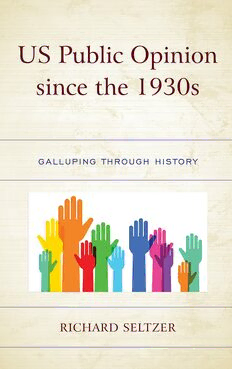
US Public Opinion since the 1930s: Galluping through History PDF
Preview US Public Opinion since the 1930s: Galluping through History
US Public Opinion since the 1930s US Public Opinion since the 1930s Galluping through History Richard Seltzer LEXINGTON BOOKS Lanham • Boulder • New York • London Published by Lexington Books An imprint of The Rowman & Littlefield Publishing Group, Inc. 4501 Forbes Boulevard, Suite 200, Lanham, Maryland 20706 www .rowman .com 86-90 Paul Street, London EC2A 4NE Copyright © 2022 by The Rowman & Littlefield Publishing Group, Inc. All rights reserved. No part of this book may be reproduced in any form or by any electronic or mechanical means, including information storage and retrieval systems, without written permission from the publisher, except by a reviewer who may quote passages in a review. British Library Cataloguing in Publication Information Available Library of Congress Cataloging-in-Publication Data Names: Seltzer, Richard A., 1951-, author. Title: US public opinion since the 1930s : Galluping through history / Richard Seltzer. Description: Lanham : Lexington Books, [2022] | Includes bibliographical references and index. Identifiers: LCCN 2021047352 (print) | LCCN 2021047353 (ebook) | ISBN 9781793653505 (cloth) | ISBN 9781793653512 (ebook) Subjects: LCSH: United States—Public opinion—History—20th century. | United States—Public opinion—History—21st century. | United States—Politics and government—20th century. | United States—Politics and government—21st century. Classification: LCC HN90.P8 S45 2022 (print) | LCC HN90.P8 (ebook) | DDC 303.3/80973—dc23 LC record available at https://lccn.loc.gov/2021047352 LC ebook record available at https://lccn.loc.gov/2021047353 ∞ ™ The paper used in this publication meets the minimum requirements of American National Standard for Information Sciences—Permanence of Paper for Printed Library Materials, ANSI/NISO Z39.48-1992. Contents Acknowledgments vii Introduction 1 1 The 1930s: The Great Depression and the Start of World War II 11 2 The 1940s: World War II and the Onset of the Cold War 29 3 The 1950s: Anticommunism, Relative Economic Prosperity at Home, and a Growing Cold War Abroad 49 4 The 1960s: Era of Protest: Civil Rights, Vietnam, and Counterculture 65 5 The 1970s: Watergate, Normalization of Relations with China, Continuing Social and Political Protest, the Growth of International Terrorism, and Stagflation 85 6 The 1980s: Ronald Reagan, the Fall of the Berlin Wall, the Soviet War in Afghanistan, and AIDS 101 7 The 1990s: The Collapse of the Soviet Union and Yugoslavia, the First Gulf War, the Genocide in Rwanda, Bill Clinton, and the Rise of the Internet 119 8 The 2000s: Decade of 9/11, the Iraqi War, the Great Recession, and the Election of Barack Obama 145 v vi Contents 9 The 2010s: War against ISIS, the Tea Party, Black Lives Matter, Brexit, and the Election of Donald Trump 167 10 2020: Covid-19, the Killing of George Floyd and Protests, an Attempt to Overthrow an Election 201 Conclusion 213 Appendix 1: Preamble to Gallup History 225 References 237 Index 245 About the Author 257 Acknowledgments As with any book project, many people deserve a lot of thanks. I thank Eric Kuntzman, my acquisitions editor at Lexington Books, for his sup- port and many useful suggestions. I also thank Jasper Mislak at Lexington Books for his very skillful editing. The Lexington Books reviewer wrote a detailed analysis of the book with numerous great suggestions. This is why the peer-review process in academics can be so important. Brenda Foust helped me with general editing and gave me a lot of very good advice on improving the manuscript. There are several people who read individual chapters and offered me very valu- able comments: Russell Canan, Larry Lynn, Gary Roth, Robert Smith, and Charles Turner. The wonderful people at the Roper Center deserve many kudos for helping me access data and answering my many queries about issues with the data. They were consistently helpful. My family is always a source of support for my writing projects and giving mean- ing to my life: Grace, Michael, Mathew, Katie, and Fred. vii Introduction This book combines two deep and enduring interests of mine: survey research and history. I’ve been conducting surveys for forty years and have loved history since grade school. When writing a recent book (Smith and Seltzer, 2015), I examined many Gallup surveys ranging from the first one, conducted in 1936, to the present. During that project, I kept getting sidetracked by looking at questions far outside my immediate research topic. I was fascinated by survey questions on the Great Depression, World War II, McCarthyism, race relations, women’s equality, sexuality, culture, the Vietnam War, and so on. I would call friends who were history buffs and say, “you wouldn’t believe what I came across today!” I then realized that other people would likely also be fascinated by the intersection of survey research and history, so I decided to write a book that uses Gallup survey questions to illustrate history.1 More importantly, we learn how the public felt about the issues at the time they were topical. This book should be helpful to historians who want to learn about what the public thought about historical events when they occurred. On the flip side, it should also be helpful to those who study public opinion who might have gaps in their under- standing of the relevant historical events. As the pun in the title implies, this is a “gal- lop through history.” In condensing seventy-five years of history and survey research to a couple of hundred pages, I will not satisfy the professional historian or pollster. However, it should provide room for thought as well as become a welcome reference. GEORGE GALLUP AND THE INCEPTION OF SURVEY RESEARCH Scientific survey research began in the 1930s arising from two traditions: journalism and market research. Public interest in the results of surveys expanded the readership 1
